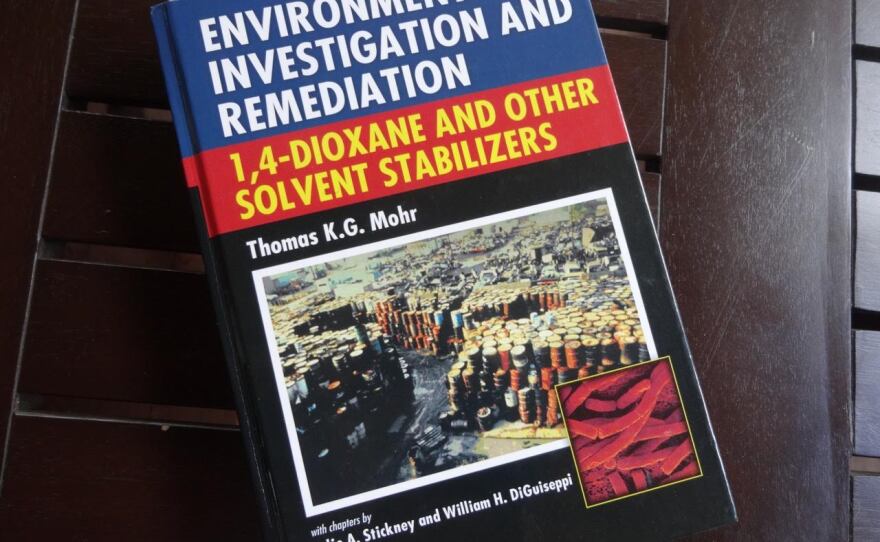A plume of 1,4-dioxane has been spreading under Ann Arbor since the 1980s. During this time, numerous homes on private wells have had dioxane in their drinking water before being hooked up to city water. Is that the only source of dioxane to consider when weighing body burdens? In the 15th of our series on 1,4-dioxane, Barbara Lucas looks at other ways people can be exposed to this chemical of emerging concern.
David Fair (DF): People in tWashtenaw County are all too familiar with 1,4 dioxane. It is a chemical that has contaminated a spreading portion of the Ann Arbor area's groundwater. The contaminant emanates from the old Gelman Sciences facility on Wagner Road in Scio Township. It is not, however, the only place you will encounter what the U-S Environmental Protection Agency calls a probable human carcinogen. While, perhaps, of lesser concern WEMU's Barbara Lucas has found dioxane exists in a plethora of other everyday items. That's the focus in our latest presentation of 'The Green Room.'
Barbara Lucas (BL): In 2009, tests of 48 top-selling children’s products found 67% contained 1,4-Dioxane—at levels up to 35,000 parts per billion, including bubble baths and best selling baby shampoos—which can be absorbed through the skin, and inhaled in water vapor.
Americans bought about 50 billion plastic water bottles last year, most of them made from PET plastic. What is a byproduct of PET production? You guessed it! Studies have found dioxane at levels of 100,000 ppb in the wastewater of PET manufacturing plants.
(Sound of Reverse Osmosis system.)
(BL): That’s the sound of an ordinary household reverse osmosis filter system. Unfortunately, such a filter cannot take dioxane out of water. But did you know there’s a chance that when first installed, it might have actually addeddioxane to drinking water? Dioxane is used in manufacturing cellulose filters, and sometimes there are traces of residual dioxane left on the filters. That’s why instructions call for flushing them out with water after first installing them.
Jeff Gearhart: Nate is working on car seat samples, so we are analyzing children’s’ car seats for hazardous flame retardants.
BL: I’m at the Ecology Center in downtown Ann Arbor, where tests are done on consumer products to detect toxic substances. Jeff Gearhart is research director. They don’t test for dioxane here, but Gearhart has been following the dioxane situation in Ann Arbor since doing his thesis on it nearly three decades ago.
Gearhart: Cellulose acetate filter production…
BL: We’re looking through a huge book chock full of sources of dioxane.
Gearhart: Printing inks, paints, adhesives, flame retardant productions, polymer production, aircraft deicing fluid, cleaning fluids. Ranges of personal care products: detergents, shampoos. And even pesticides.
BL: The list goes on. Pharmaceuticals, plastics, food. And, because so much ends up in landfills, landfill leachate is a common source of dioxane.
Gearhart: It’s ubiquitous throughout chemistry, really.
BL: Gearhart tells me about Green Chemistry.
Gearhart: It's really going back to the chemist and saying let’s figure out how can actually do chemistry that’s highly efficient, that’s green, that doesn’t bring these other chemicals along for the ride.
BL: He says it’s a preventable situation.
Gearhart: We need to take a step back and look at product design and chemistry design, and understanding that these are consumable products that end up going someplace. Dioxane is a great example of some of these problems.
BL: He says it’s also a failure of priorities.
Gearhart: People call them environmental disasters, like Flint, but really they are predictable outcome of a systematic disinvestment in environmental and health regulations, and environmental and health infrastructure.
BL: There’s no law regulating dioxane in our food, soaps, or other consumable products. Gearhart says it’s not an intentional ingredient, it’s left over from manufacturing processes—a contaminant.
Gearhart: Consumers are always in a difficult spot. That’s one of the reasons we continue to push for full ingredient disclosure, including contaminants that may be in products.
BL: Until then, there’s the internet. Unfortunately, when I google products containing 1,4-dioxane, I find my favorite laundry detergent, my favorite dish soap, and my favorite shampoo.
Barbara Lucas, 89 One, WEMU News
Resources:
Toxicological Profile for 1,4-Dioxane.
“Shampoo Labels Don’t Come Clean,” Ecology Center.
“Children’s Bath Products Contaminated With Formaldehyde, 1,4-Dioxane,” Environmental Working Group.





